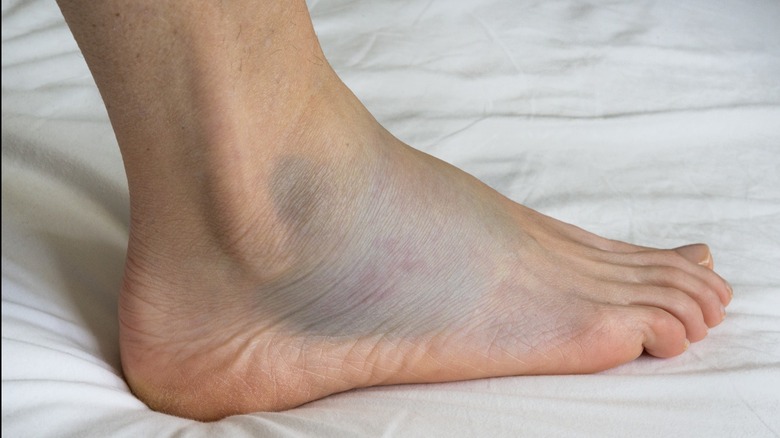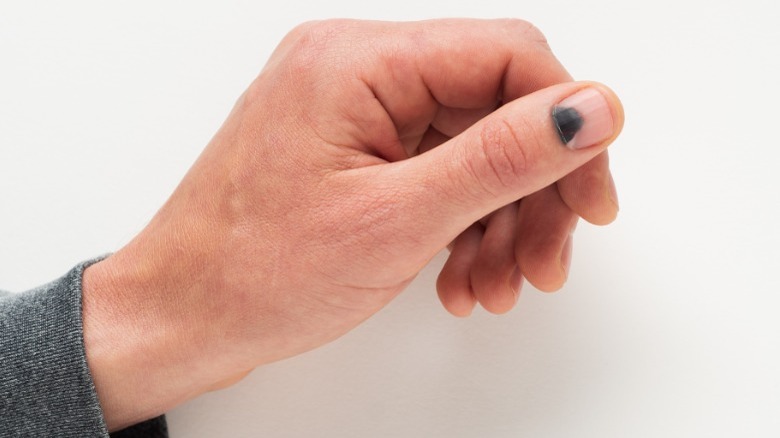How To Care For A Hematoma At Home
If you injure yourself and your skin becomes discolored, what you might assume is a bruise could actually be a hematoma. Often confused with bruises, hematomas (or contusions), exhibit some similar qualities as bruises, but typically have different causes, symptoms, and risk factors.
According to the experts at Mercy Health, when you develop a bruise a few hours after a mild accident or bump, the injury causes microscopic tears in the small veins and capillaries beneath your skin, trapping the pooled blood and leading to dark discoloring and tenderness. However, not only mild injuries can cause bruises. Bruises can also be the result of unexplained bleeding in some. Additionally, people will typically develop bruises more easily as they age due to thinner skin. Nevertheless, whatever your age, you will generally be at higher risk of bruising if you have low levels of vitamin C, a bleeding disorder or you are on blood thinners.
Though bruises typically go away on their own, you can support the healing process and ease some of the discomforts in a few ways. For instance, to reduce swelling, wrap a thin towel around an ice pack and apply this to the affected area for 20 minutes intervals. Do this several times throughout the day as a way to potentially help reduce pain and swelling. If this treatment isn't quite doing the trick, try placing an elastic bandage around the affected area, being careful not to make it too tight. A non-prescription pain reliever you've used before may also be helpful in reducing discomfort.
Hematoma types and seriousness
One notable aspect of hematomas that separates them from bruises is that there are several types of hematoma, and, depending on the location and severity, having a hematoma can have serious health consequences.
Specific types of hematoma are identified by their location in your body. For instance, head trauma from a car accident or sports-related injury can cause blood to pool between the inside of the skull and the lining of the brain, which is called an "intracranial hematoma," according to the experts at Mayo Clinic. If blood vessels burst and put pressure on the brain tissue, this is what is known as a "subdural hematoma," which can be life-threatening. Some symptoms of intracranial hematoma include a worsening headache, dizziness, vomiting, slurring of speech, and loss of movement or paralysis on the opposite side of the body in relation to the side of your brain that experienced the impact. If following a head injury — even if some time has passed since the incident — you begin to experience loss of consciousness or any of the aforementioned symptoms associated with an intracranial hematoma, you should seek medical attention immediately, per Mayo Clinic.
However, a hematoma can happen in many other places in the body, with the website MedicalNewsToday explaining that hematomas are categorized depending on the location where they occur. For instance, you can get an ear hematoma, scalp hematoma, or a hematoma in your liver (hepatic hematoma); or, if you break your nose, you could develop a sepal hematoma, which can lead to serious issues if left untreated.
Home remedies to manage a hematoma
Thankfully, the kind of hematoma you're most likely to experience is common and often goes away on its own. However, you can take steps to help move the healing process along.
For instance, if you have a superficial hematoma under your skin or in the soft tissue of a muscle, you can treat it similarly to a bruise using the RICE method: rest, ice the area for 20-minute intervals between four and eight times per day, compress the area using an elastic bandage and elevate the afflicted limb so the hematoma is above the heart. Though there is no medication specifically designed to treat hematoma, you can try an over-the-counter pain reliever, such as Tylenol (acetaminophen), to help manage symptoms and reduce discomfort. However, if you have any underlying health conditions, it's a good idea to check with your doctor first to describe the situation and confirm the safest medication for your situation.
According to the experts at MedicineNet, you'll know when your hematoma is resolving in a few ways. For instance, the firmness of the hematoma should begin to become more spongy as the blood clot breaks down. You should also notice the hematoma flatten and change in shape as the fluid drains. Another sign that the hematoma is healing is that you will notice it changing color, transforming from dark purple to yellowish.
However, if the hematoma lump grows in size or turns red or you become feverish, it's best to seek medical attention.



